19 Best Arm-Toning Workouts for Women Who Want Sculpted Shoulders and Biceps
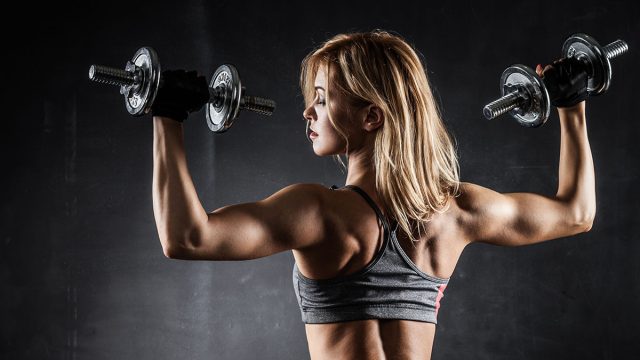
Finding the right arm-toning workouts for women looking to achieve sculpted shoulders and biceps is now easy with the help of this curated collection by fitness pros. We'll explore exercises recommended by leading experts, including Portia Page, who introduces us to the simplicity and effectiveness of countertop push-ups and plank rocks, and Petrina Barber, who guides us through the foundational yet transformative world of push-ups, tricep-dips, and the equally effective pull-ups.
Miranda Esmonde-White, a former ballerina turned fitness trainer, shares insights into the importance of engaging both major and micro muscle groups, while Lesley Logan, a Pilates expert, emphasizes the precision and control integral to Pilates exercises for arm toning. Kamille McCollum introduces Reformer Pilates moves for an added challenge, and Nader Qudimat, along with Jose Guevara, rounds out our expert advice with their take on integrating equipment like dumbbells and cable machines for arm sculpting success. Join Body Network as we navigate through these expert-recommended routines designed for women seeking to tone, sculpt, and redefine their upper body strength.
Countertop Push-Ups
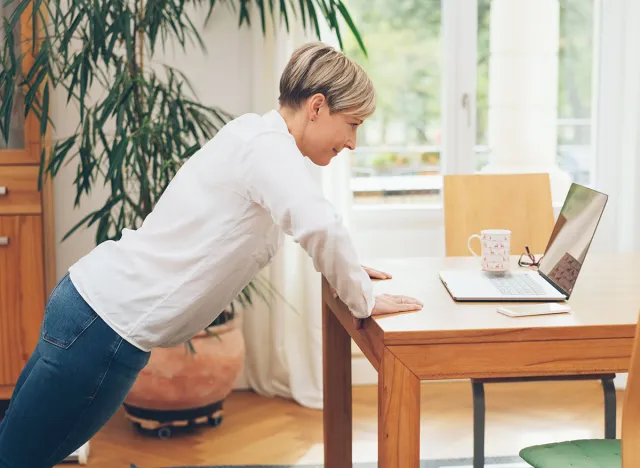
Portia Page, PMA, ACE and AFAA certified and Balanced Body Educator, recommends two easy exercises you can do at home that helps tone shoulders and biceps. The first is countertop push-ups. "Place hands on top of desk, and step back until body is in one long diagonal line. Bend and straighten arms. As arms bend, body lowers toward desk, as arms straighten, body returns to starting position. Although arms are working hard, spinal muscles and core are working to support the spine, and legs should be active to support lower body. Ten repetitions is all you need.
Plank Rock
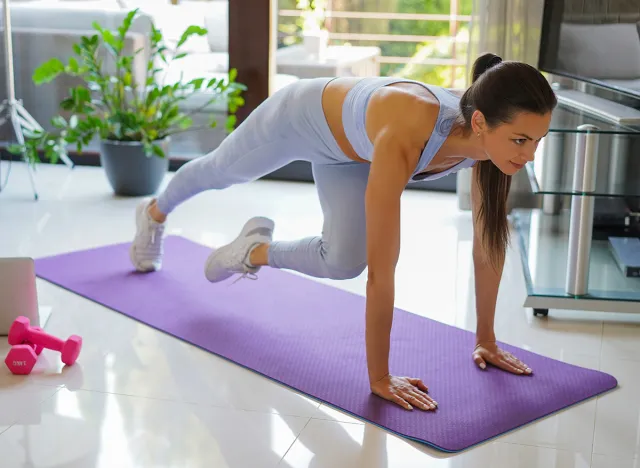
"Come to the floor on all fours with the knees under the hips and the hands under the shoulders. Straighten one leg, then the other, keeping the back long and straight. Rock forward on the toes and back to bring the heels forward and back while keeping the spine long and straight. Repeat the rocking back and forth for 1-minute," says Page. "Why is this important? It works the entire body while building strength and control in the upper body and arms."
Push-Ups
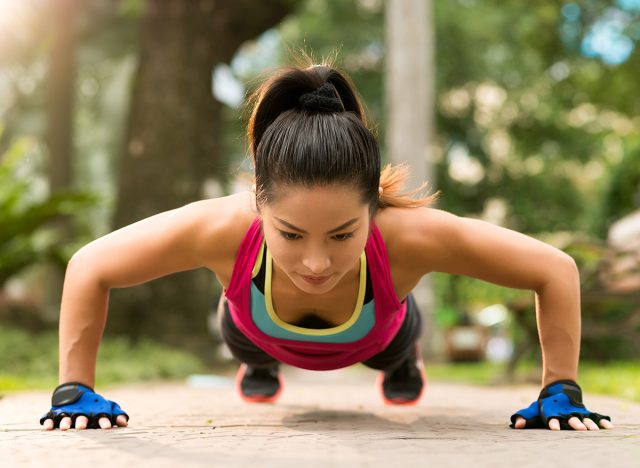
Petrina Barber, fitness expert and founder of Beyond the Stoma, recommends three top workouts to sculpt and tone arms and shoulders for any fitness level. The first is a classic: pushups. "Push-ups are a classic compound exercise that uses more than one muscle group. The shoulders, the chest and arms are engaged during a push-up. The great thing about pull-ups is they can be modified to suit different fitness levels, making them ideal for beginners as well as more advanced fitness enthusiasts," she says.
"In practice: If you are a beginner start with an incline such as a wall or bench. This will reduce the intensity but still engage enough muscles to make it challenging at the start of your fitness journey, allowing you to build up slowly at your own pace. When you feel ready for more, progress the workout by practicing what is commonly seen as a 'traditional push-up' – this is where the push-up is performed on the floor and one's own full body weight is used. A traditional push-up involves keeping your knees on the floor, or for more of a challenging push-up, use your toes, keeping your knees off the ground to really activate your core muscles. An even more difficult variation involves a decline or diamond push-up which uses gravity and a change in weight distribution to target smaller muscles and more intensity to make it more difficult."
RELATED: 5 Foods to Melt Your Belly Fat Away
Tricep-Dips
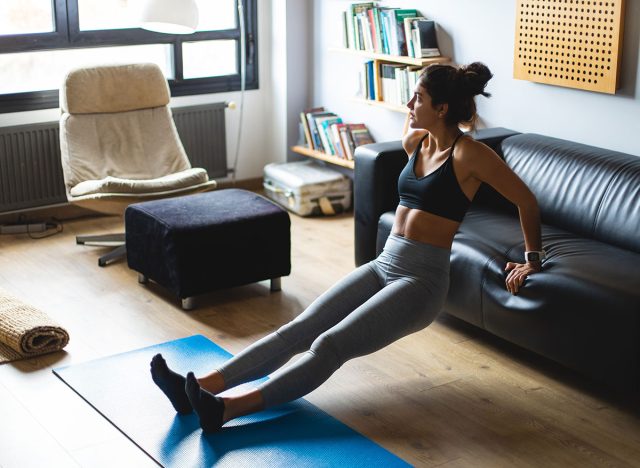
"We've all heard of biceps, but triceps are the muscles on the back of the upper arm. As we age or if you have experienced significant weight loss, their appearance can appear saggy due to loss of skin elasticity and a natural decrease in muscle mass, which is common, especially as we mature. Tricep-dips are great as they target this area and with repetition, you can slowly define muscle whilst also engaging the chest and shoulders," says Barber.
"In practice: To start, sit on the edge of the chair with your hands placed approximately shoulder-width apart, holding tightly to the edge. Then, extend your legs out in front of you, ensuring your heels are on the floor. Once in a stable position, slowly lower your body by bending the elbows to 90-degrees. Then pull back up to your starting point. If it is the first time performing a tricep-dip its advisable to bend your knees and ensure your feet are closer to your body. This will reduce the intensity of the move ensuring you are not putting too much stress or pressure on your body. When you feel ready to up the game, do so by extending your legs fully and you could even go one step further by elevating your feet on another surface which will increase the intensity of the workout even further as you will be working against gravity."
Pull-Ups
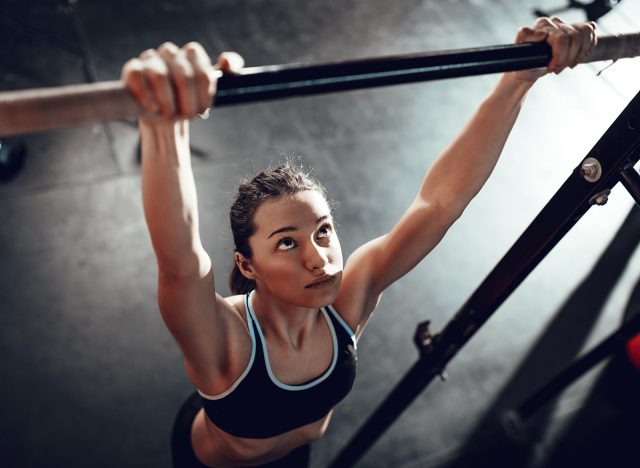
"Pull-up or an assisted pull-up is a brilliant exercise for targeting the biceps, back and shoulders. It is one of my personal favorites albeit more challenging than push-ups and tricep-dips. A pull-up is challenging because it involves lifting up your entire body weight using your arms but great at building up muscle definition. You might want to start with assisted pull-ups if you are a beginner to help guide you without risking injury. If in the gym, pull-up machines are a great way to perform a pull-up with guidance/assistance and you can gradually up your reps and increase the weights when you feel ready," says Barber.
"In practice: If you are performing a pull-up stand with your feet on the ground and then grip the bar with your hands slightly wider than shoulder-width apart. Ensure the palms of your hands are facing away from you. Always engage your core and make sure your posture is aligned properly to avoid injury – ensuring your shoulders are pulled down and back, also ensuring you keep the same movement with each movement and rep. Maximize the benefits of the exercise with a smooth range in the motion pulling your chin as close to the bar or higher if you can, pushing your elbows towards the floor."
Barber adds: "Remember, desired results take time. Whether you are a beginner or advanced and looking to progress further, consistency is the key to progression. Always listen to your body and build up slowly. It is ok if it is a gradual process! Seek an expert trainer/PT if you are embarking on a new fitness journey to ensure you are doing things properly/safely and effectively."
Pumping Arms

Miranda Esmonde-White proposes a key exercise taken from the Essentrics toning and strengthening workout that she created, as a former ballerina turned fitness trainer to numerous professional athletes and Olympians. "It's important to create a well-balanced muscular body to avoid injury when trying to build strength. When toning arm exercises that work our major muscle groups such as the biceps and shoulders, and the micro muscles aren't engaged, they slowly shrink and atrophy from disuse. The stabilizing muscles are no longer strong enough to do the job of protecting the joints. This leads to joint damage," she says.
"Essentrics offers arm exercises that fully engage all major and minor muscles groups to ensure equal strength, flexibility and balance. One's arms are already a sufficient weight to lift when trying to strengthen the shoulders and spine. You don't need to add additional free weights to strengthen your muscles. The following is an eccentric exercise that strengthens the muscles by lengthening them, which reverses compression on the joints, and relieves and prevents joint pain.
When you do this movement of lifting your arms without weights, you can actually relax the joint muscles and actively pull the muscles into a lengthened position.
RELATED: Simple Full Body Home Workout For Small Spaces
Here's the Pumping Arms movement:
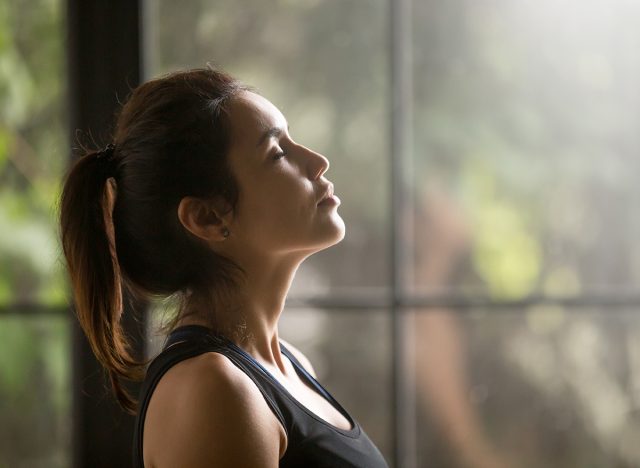
"Use visualization to stimulate your neurons: Imagine pressing your arms down against an invisible force that prevents you from lowering them both rapidly and more than a few inches.
This sequence will strengthen and stretch the connective tissue of your underarms, helping to reduce unwanted underarm flab. It helps strengthen the bones of your spine to prevent and reverse osteoporosis and will improve your posture. It lengthens the shoulder girdle muscles, giving you more range of motion in your arms.
You should be feeling the work in your shoulders, underarms, biceps and upper back muscles (trapezius).
- Start with your legs slightly wider than hip-width distance apart, with your feet comfortably placed on the floor. Some people are more comfortable with their feet slight turned slightly in, and others prefer to have their feet slightly turned out. Choose the position that works best for you. Keep your knees and spine straight.
- Extend both arms to shoulder height, elbows straight.
- Slowly pump your arms downward, pushing against an invisible force. Don't let them move more than 3 or 4 inches from their starting position.
- Repeat 16 times.
- Slowly pump your arms backward, pushing against an invisible force. This movement will be small. The arms are capable of moving only 2 to 3 inches back from your starting position. Be careful not to let your back move forward into an arched position as you pump the arms back. Hold your core tight to protect your back.
- Repeat 16 times.
- Repeat the complete sequence again."
Shoulder Bridge
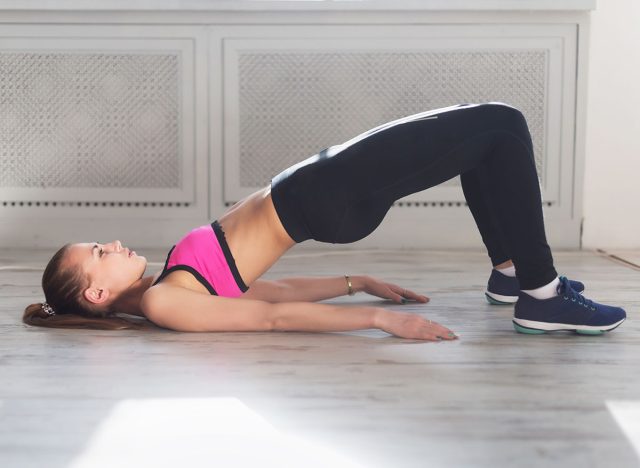
"Here are some proven Pilates workouts tailored for women seeking sculpted shoulders and biceps," says
Lesley Logan, Pilates Expert at OnlinePilatesClasses.com. "These Pilates exercises offer a comprehensive approach to sculpting and toning the shoulders and biceps, focusing on controlled movement, proper alignment, and engaging the targeted muscles effectively. Integrating these workouts into your routine can help achieve defined and strong arms."
For Shoulder Bridge, "start lying on your back with your knees bent and your feet hip-width apart. Lift your hips into a bridge position, engaging your glutes and abdominals. Extend your arms overhead, then bring them back to the sides of your body, maintaining stability in your shoulders and core. Repeat several reps, focusing on controlled movement."
Push-Up With Shoulder Stability
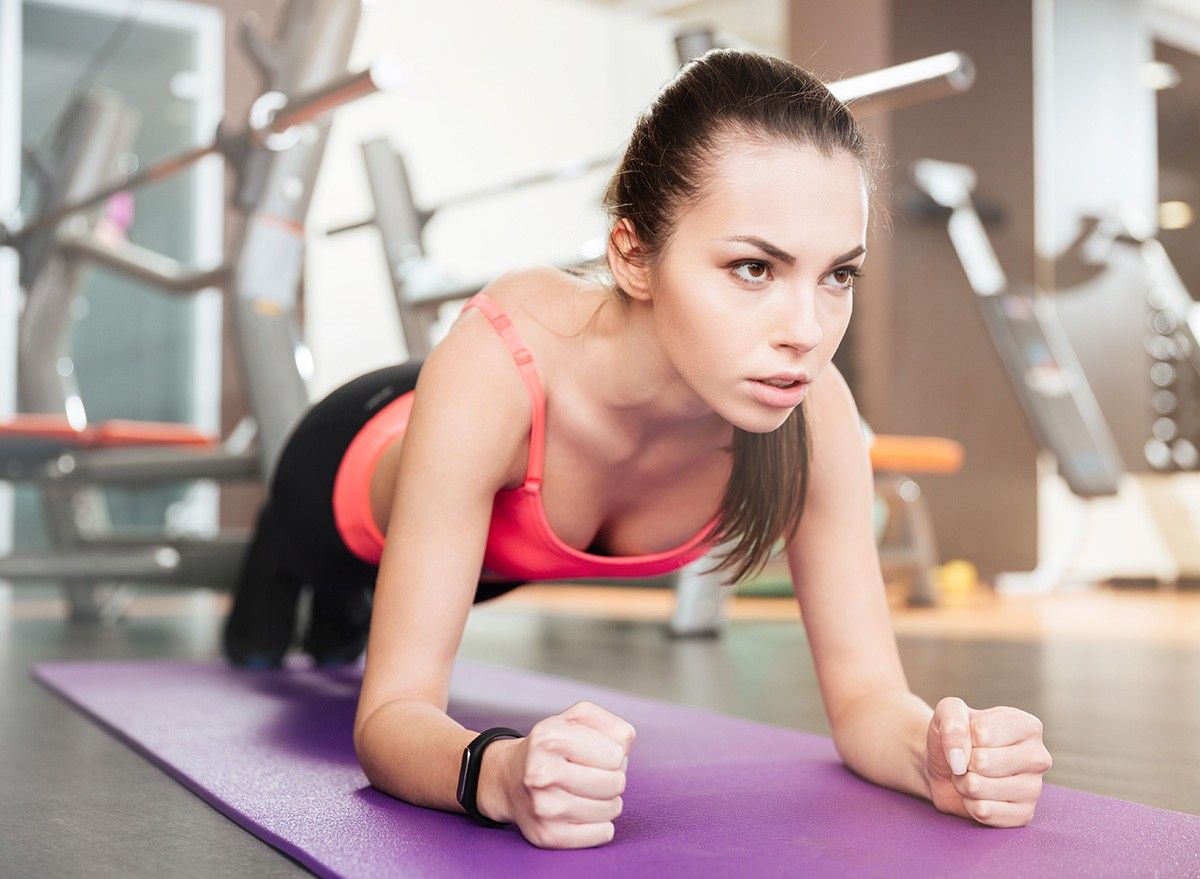
"Begin in a plank position with hands directly under shoulders. Lower into a push-up while keeping your shoulders stable and core-engaged. As you press back up, narrow your elbows and focus on engaging your biceps and shoulders to lift your body. Modify as needed by performing push-ups on your knees or using a higher surface for elevation," says Logan.
Related: This Is Exactly How to Lose Body Fat This Year
Arm Circles with Resistance Band
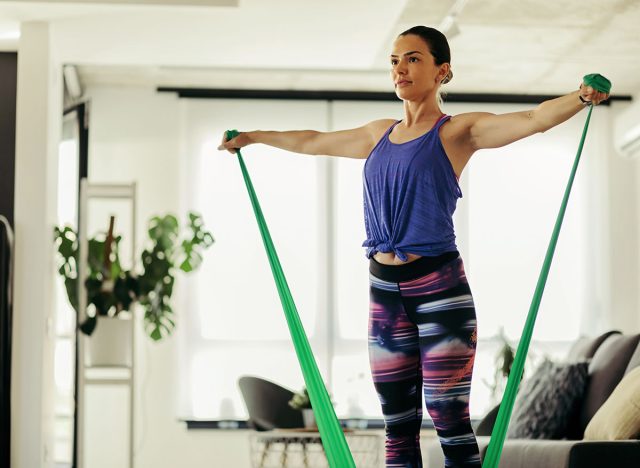
"Stand tall with feet hip-width apart, holding a resistance band in both hands. Extend your arms straight out to the sides at shoulder height. Make sure your core is engaged, and make small circles with your arms, gradually increasing the size of the circles. Reverse the direction after several reps. This exercise targets the shoulders and engages the biceps as you maintain tension in the band," says Logan.
Side Bend
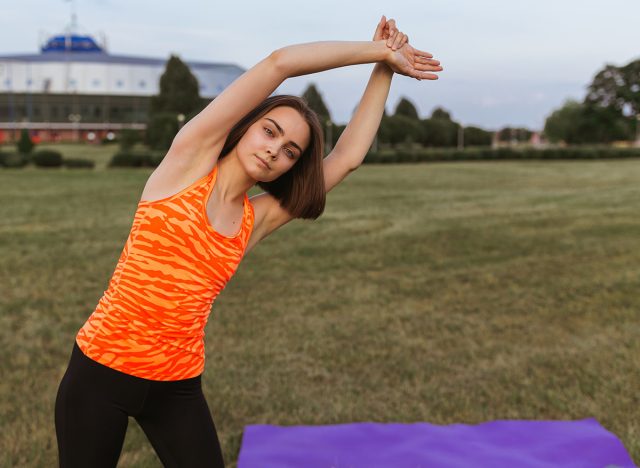
"Pilates involves engaging the core muscles while laterally flexing the spine, often performed in a seated or standing position with arms extended overhead. This movement helps strengthen the obliques, deep abdominals, and muscles along the sides of the torso, promoting better posture and spinal alignment. Additionally, as the arms are typically extended overhead during side bends, they are actively engaged to stabilize the shoulders and maintain balance, thus contributing to improved arm strength, particularly in the shoulder and upper arm muscles. Regular practice of side bend Pilates enhances core stability and aids in toning and sculpting the arms, making it a beneficial exercise for overall strength and flexibility," says Logan.
Rowing with Weights
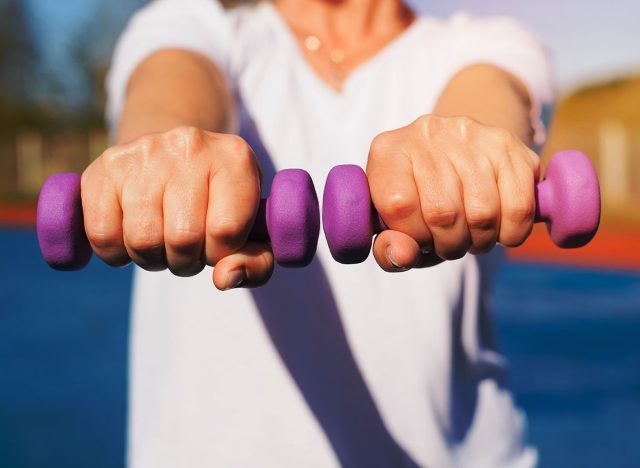
"Rowing with weights involves sitting upright with legs extended, arms holding weights, and shoulders relaxed. The movement entails simultaneously pulling the arms back in a rowing motion while engaging the shoulder blades, activating the biceps and shoulders. This exercise targets multiple muscle groups, including the biceps, shoulders, upper back, and core, promoting strength and stability in the upper body. Pilates rowing with weights strengthens the biceps and shoulders by incorporating controlled, fluid movements. It improves posture and overall upper body tone, making it an effective workout for sculpting and defining these muscle groups," says Logan.
Work With Light Weights
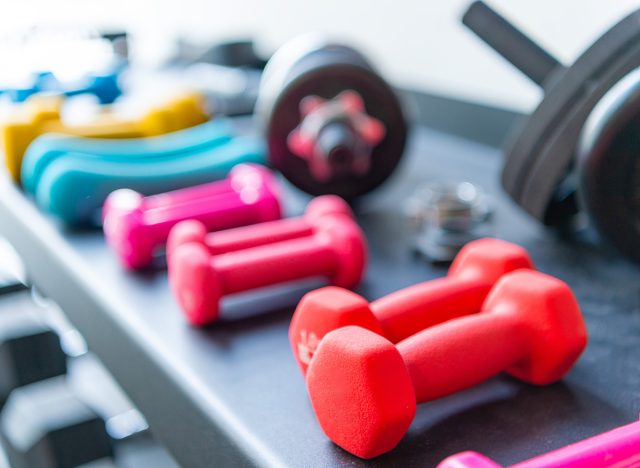
"To achieve sculpted shoulders and biceps it is extremely important women change the type of workout they do each day. Working with light weights (ex: barre and Pilates) alternating with a heavier weight workout is ideal to change the stimulus on the muscles. This will sculpt and tone the biceps/shoulders in the best possible way. Working the biceps/shoulders 3-4 times a week is ideal to see change/avoid burnout," says Cara D'Orazio, a certified personal trainer, group fitness instructor, and specialist in sports conditioning through the American College of Sports Medicine for eighteen years.
Related: Benchmark Your Progress with Our Lean Body Mass Calculator
Hug the Tree (Reformer Required)
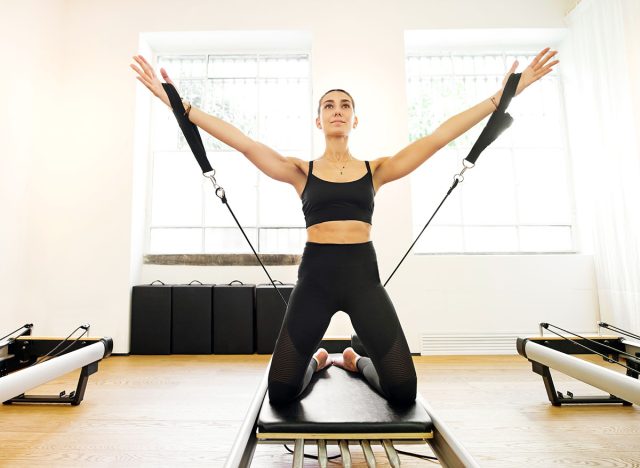
Kamille McCollum, a pilates expert at BODYBAR Pilates, offers some Reformer Moves, starting with Hug the Tree. "This ballet-inspired move is a great exercise for toning the arms. Kneeling with the core engaged, participants slowly round their arms overhead, with one hand holding the reformer cable handle, mimicking the act of hugging the tree. For an added challenge, incorporating a weight in the outer arm intensifies the workout, ensuring that both arms receive equal attention."
Draw a Sword (Reformer Required)
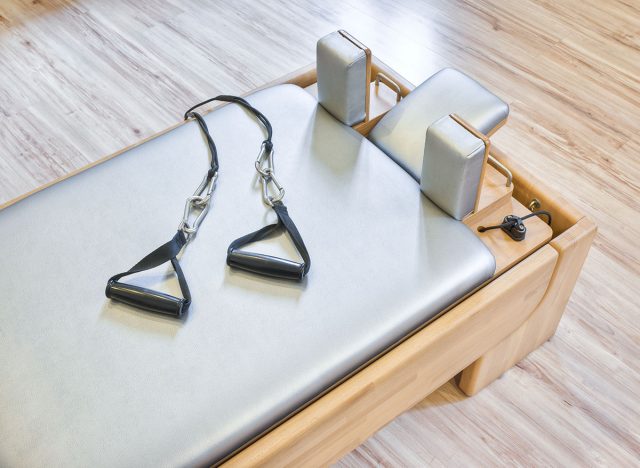
"This exercise is a super sculptor. Kneeling with the core engaged, and with one hand holding the reformer cable, extend the arm from the hip across the body and up to the sky. It simulates the motion of a pirate drawing a sword and raising it overhead. The effectiveness of this exercise lies in the separation of movements—waiting to extend the arm until the elbow reaches its peak height," says McCollum.
Tricep Dips
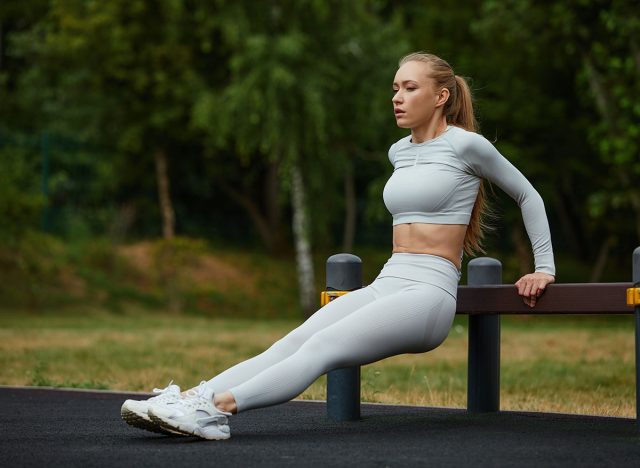
"Using a chair or bench that does not move, place hands on the edge at shoulder width, lower yourself until your elbows are at a right angle, then push up. It's a classic that never fails," says McCollum.
Plank Ups
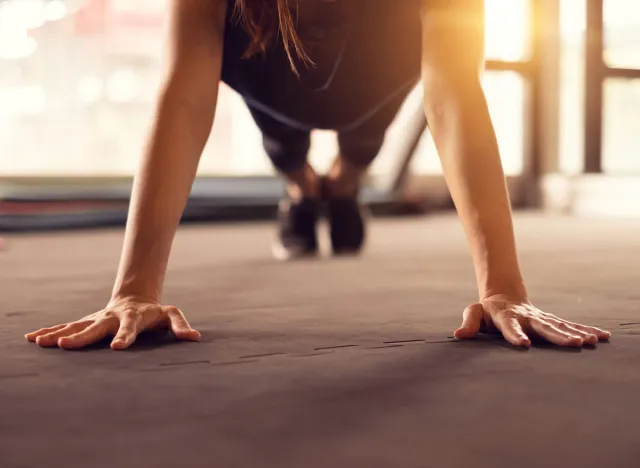
"Start in a plank position. Lower into a forearm plank, one arm at a time, then press back up to your hands. Think down, down, up, up," says McCollum.
Arm Circles
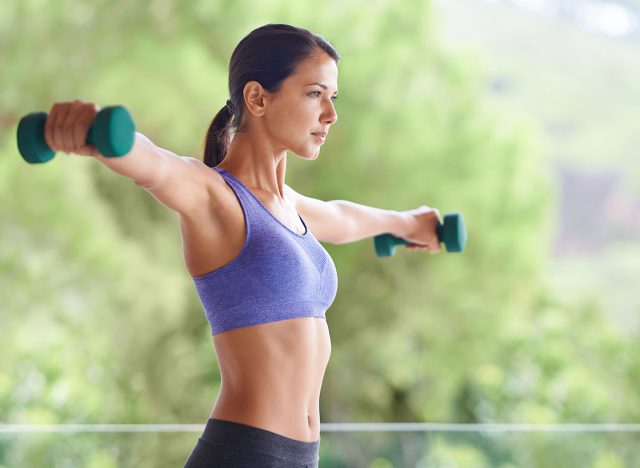
"Standing tall with feet hip distance apart, extend arms out to the sides and draw small circles. For extra credit, add light weights," says McCollum.
Deadlifts, Dumbbell Shoulder Presses and More
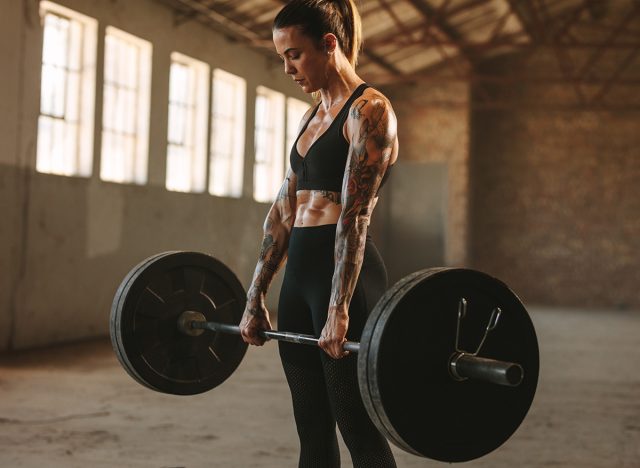
"Deadlifts are the most comprehensive exercise, as they are the ultimate workout multitasker, engaging almost every muscle group, including the arms for unmatched efficency," says Nader Qudimat, Bodybuilding Specialist and Consultant at Bodybuildingreviews.com. Additionally:
- "Dumbbell shoulder presses do more than strengthen, they sculpt the shoulders into personal strength and dedication. Concentration curls are about connecting the mind to the muscle, focusing completely on one bicep at a time.
- Modified push ups are not only a great upper body exercise but they also improve our perception of strength, allowing for progressive overload.
- With bent over reverse fly, we're focusing on muscles that complete the shoulder roundness, ensuring they are toned all around.
- The essence of resistance band bicep curls is to provide a consntant source of tension, throughout the entire rep.
- The simplicitiy of arm circles offers a gentle but potent way to enhance shoulder endurance.
- Tricep dips are a great way to challenge your body's limits, helping enhancing your endurance and strength while enhancing the way your arms look.
Cable Machine Workout
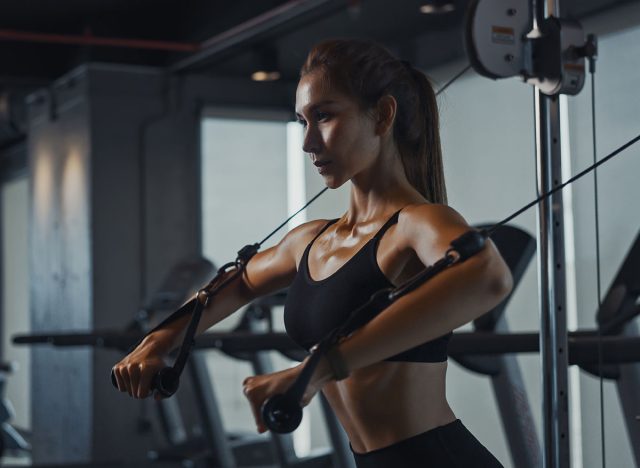
"Look to a cable machine to carve sculpted shoulders and biceps," says Jose Guevara, Shredded Dad. "The constant resistance created by a cable machine keeps muscles under tension for longer periods of time, giving you better results. For sculpted shoulders working the middle deltoid is essential to create definition and 'separation' between the arm and shoulder. Lateral raises on a cable machine or with resistance bands allow for constant tension through the full range of motion of the exercise. Compare that to dumbbell lateral raises, where you lose tension in the deltoids at the bottom of the exercise where your arm just hangs.
Same goes for the biceps…Do bicep curls on a cable machine to experience constant tension.Practice a combination of standing bicep curls, preacher curls, incline bicep curls, and you'll get some nice, defined guns. Combine those exercises with a caloric deficit to lose fat and you'll have defined arms."
💪🔥Body Booster: Getting the results you want takes time. If you're just starting out or looking to take it further, being consistent is what matters most. Listen to your body and take it slow. Stick with it and you'll get there.




